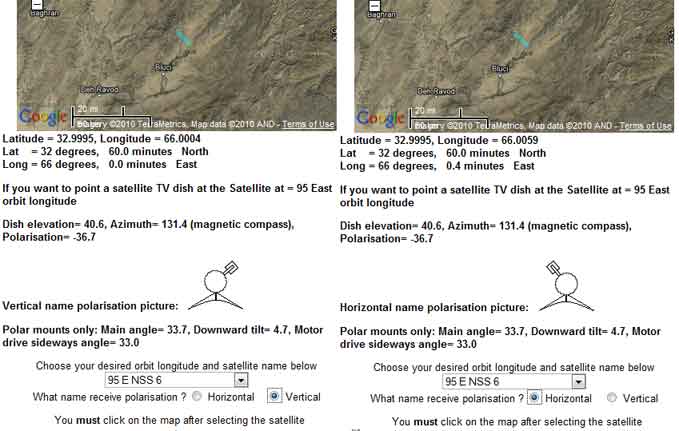Post by Eric Johnston on Apr 21st, 2010 at 5:17pm
Here are two displays from the Iraq Dish pointing calculator, for NSS6 satellite (95 east orbit position) and somewhere in Afghanistan.
You need to do it for your satellite and location.
Polarisation:
Step 1.
Horizontal receive polarisation starting position is with the LNB uppermost, central above the BUC.
Vertical receive polarisation is acehived with the LNB arm sticking out sideways - which side does not matter.
Step 2:
You then apply the polarisation adjustment angle. In the above images the polarisation adjustment angle is -32 deg anticlockwise, with you facing towards the satellite in the sky. See the pictures of the feed horn window and the position of the LNB. These images move and change to give you the idea. In the case of vertical I assumed that you put the LNB out on the right hand side as its starting position. Set the adjustment angle exactly using an inclinometer placed sideways across the BUC or LNB.
I don't understand your elevation angle of 15 or 17 deg. Is this the reading on the scale behind the dish?. Maybe it is the slope of the front face of the dish?. If you are using the slope of the front face of the dish it is possible that your dish offset angle is about 25 deg. The offset figure needs to come from the dish manufacturers manual/installation instructions. The offset angle is the beam elevation angle when the front face of the dish is vertical. A figure of around 25 deg is typical.
Have you tried the other polarisation ?
Best regards, Eric.
You need to do it for your satellite and location.
Polarisation:
Step 1.
Horizontal receive polarisation starting position is with the LNB uppermost, central above the BUC.
Vertical receive polarisation is acehived with the LNB arm sticking out sideways - which side does not matter.
Step 2:
You then apply the polarisation adjustment angle. In the above images the polarisation adjustment angle is -32 deg anticlockwise, with you facing towards the satellite in the sky. See the pictures of the feed horn window and the position of the LNB. These images move and change to give you the idea. In the case of vertical I assumed that you put the LNB out on the right hand side as its starting position. Set the adjustment angle exactly using an inclinometer placed sideways across the BUC or LNB.
I don't understand your elevation angle of 15 or 17 deg. Is this the reading on the scale behind the dish?. Maybe it is the slope of the front face of the dish?. If you are using the slope of the front face of the dish it is possible that your dish offset angle is about 25 deg. The offset figure needs to come from the dish manufacturers manual/installation instructions. The offset angle is the beam elevation angle when the front face of the dish is vertical. A figure of around 25 deg is typical.
Have you tried the other polarisation ?
Best regards, Eric.

